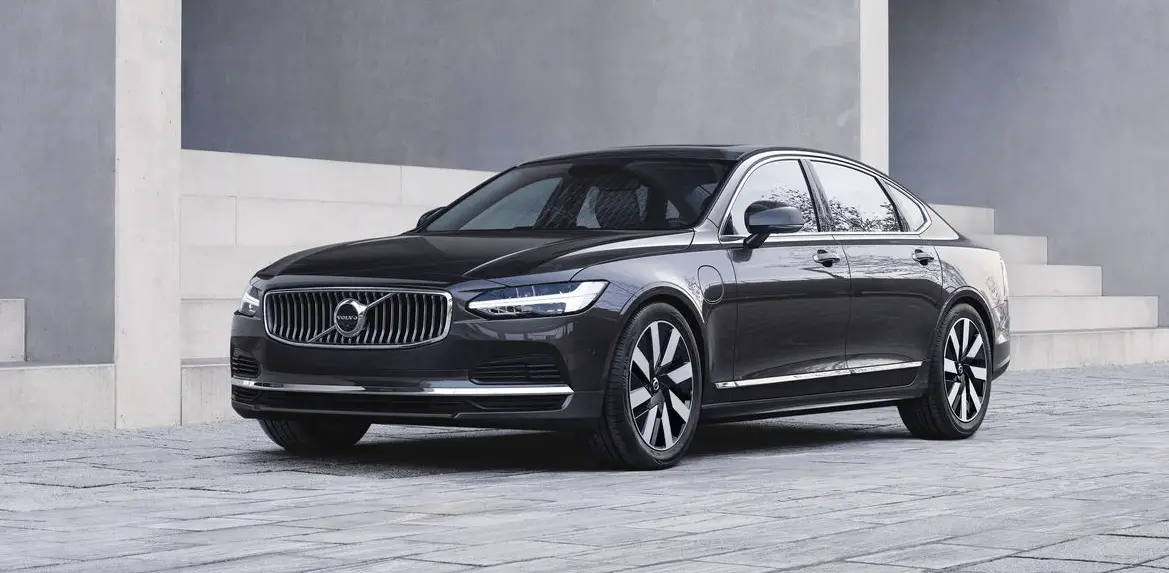 Volvo S90 2021-2023 LOADING, STORAGE AND PASSENGER COMPARTMENT User Manual
Volvo S90 2021-2023 LOADING, STORAGE AND PASSENGER COMPARTMENT User Manual
LOADING, STORAGE AND PASSENGER COMPARTMENT
Passenger compartment interior
Overview of the passenger compartment’s interior and storage locations.
Front seat
Storage compartment in the door panel and by the steering wheel, glovebox and sun visors.
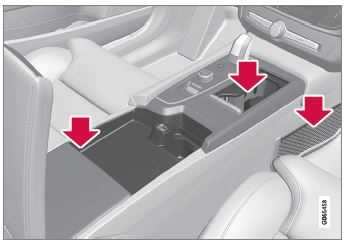 Storage spaces with cup holder, electrical socket, mesh pocket* and USB port in the tunnel console.
Storage spaces with cup holder, electrical socket, mesh pocket* and USB port in the tunnel console.
Rear seat
Storage compartment in the door panel, cup holder* in the centre seat backrest, storage pocket* on the front seat backrest and also USB ports in the tunnel console.
WARNING
Keep loose objects such as mobile phones, cameras, remote controls for accessories, etc. in the glove compartment or other compartments. Otherwise they may injure people in the car in the event of sudden braking or a collision.
IMPORTANT
Keep in mind that high gloss surfaces, for example, are easily scratched by metal objects. Do not place keys, phones and other items on sensitive surfaces.
Related information
- Electrical sockets (p. 591)
- Using the glovebox (p. 593)
- Sun visors (p. 594)
- Tunnel console (p. 591)
- Connecting a device via USB port (p. 526)
Tunnel console
The tunnel console is located between the front seats.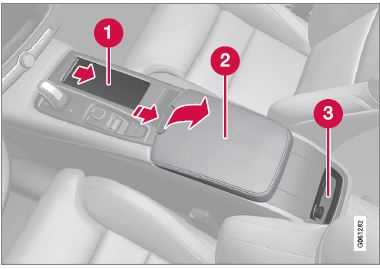
- Storage compartment with cup holder.
- Storage compartment with 12 V socket and USB port under the armrest.
- Climate controls for the rear seat climate functions* or storage compartment. There are also USB ports underneath.
WARNING
Keep loose objects such as mobile phones, cameras, remote controls for accessories, etc. in the glove compartment or other compartments. Otherwise they may injure people in the car in the event of sudden braking or a collision.
IMPORTANT
Keep in mind that high gloss surfaces, for example, are easily scratched by metal objects. Do not place keys, phones and other items on sensitive surfaces.
NOTE
One of the detectors for the alarm* is located under the tunnel console’s cup holder. Avoid leaving coins, keys and other metal objects in the cup holder, since this may trigger the alarm.
NOTE
The USB sockets can be used for charging a mobile phone or tablet, for example. Only the front USB input can be used to play media in the car’s audio system.
Related information
Electrical sockets
There is one 12V electrical socket in the tunnel console and one 12V electrical socket* in the luggage compartment/cargo area. If a problem occurs with an electrical socket, contact a workshop – an authorised Volvo workshop is recommended.
12 V electrical socket 12 V electrical socket in tunnel console, front seat. The 12 V sockets can be used for various accessories designed for this, such as music players, cooler boxes and mobile phones.
12 V electrical socket in tunnel console, front seat. The 12 V sockets can be used for various accessories designed for this, such as music players, cooler boxes and mobile phones.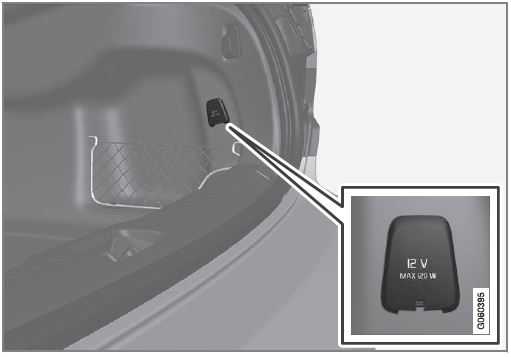
12 V electrical socket in cargo area*.
Related information
Using electrical sockets
12 V sockets can be used for various accessories designed for this, such as music players, cooler boxes and mobile phones. For the sockets to supply current, the car’s electrical system must be set in the lowest ignition position I. The sockets are then active as long as the starter battery level does not become too low. If the engine is switched off and the car is locked, the sockets are deactivated. If the engine is switched off and the car is not locked, or is locked with double lock temporarily deactivated, then the sockets continue to be active for a further seven minutes.
NOTE
Remember that use of the electrical socket with the engine switched off entails a risk of discharging the starter battery, which can limit functionality.
Accessories that are connected to the electrical sockets may be activated even when the car’s electrical system is disconnected or if preconditioning is used. For this rea-son, disconnect the connectors when they are not in use in order to avoid the starter battery being discharged.
WARNING
- Do not use accessories with large or heavy connectors – they can damage the socket or come loose when driving.
- Do not use accessories that can cause interference to the car’s radio receiver or electrical system for example.
- Position the accessory so that it is not at risk of injuring the driver or passengers in the event of heavy braking or collision.
- Keep an eye on connected accessories as they can generate heat that can burn passengers or the interior.
Using 12 V sockets
- Remove the blanking plug (tunnel con-sole) or fold down the cover (cargo area) in front of the socket and plug in the accessory’s connector.
- Unplug the accessory’s connector and refit the blanking plug (tunnel console) or fold up the cover (cargo area) when the socket is not in use or if the socket is left unattended.
IMPORTANT
Maximum socket output is 120 W (10 A) per socket.
Related information
Using the glovebox
The glovebox is located on the passenger side. The printed owner’s manual and maps can be kept in the glovebox, for example. There is also space for a pen and card holder.
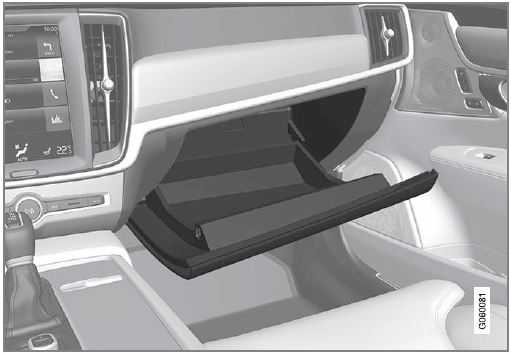 Locking and unlocking the glovebox
Locking and unlocking the glovebox
The glovebox can be locked, e.g. when the car is taken in for service, left at a hotel or similar. The glovebox can only be locked/unlocked with the accompanying key.
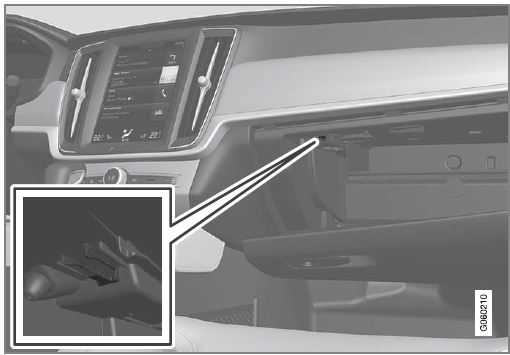 The key’s designated storage space. The figure is schematic – the design may vary.
The key’s designated storage space. The figure is schematic – the design may vary.
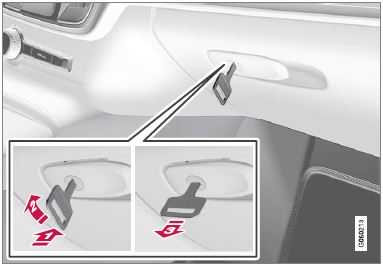 The figure is schematic – the design may vary.
The figure is schematic – the design may vary.
- Locking the glovebox:
- Insert the key in the glovebox lock cylin-der.
- Turn the key 90 degrees clockwise.
- Pull out the key.
- Unlock by carrying this out in reverse order.
Related information
Sun visors
There are sun visors in the roof in front of the driver seat and the front seat passenger seat which can be folded down and angled out to the side when necessary.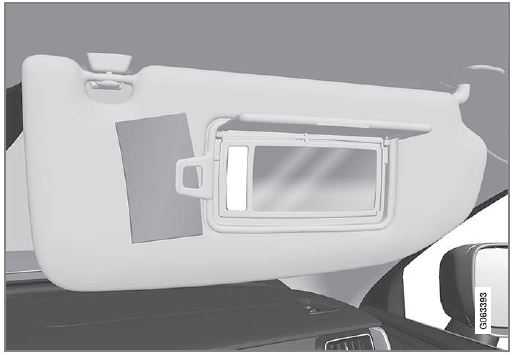
- The figure is schematic – the design may vary.
- The mirror lighting* is switched on automatically when the guard is lifted up.
- The mirror frame incorporates a holder for e.g. cards or tickets.
Related information
Cargo area
Inside the car’s cargo area, it is possible to secure the load so that it stays in place while driving. With folding* backrests in the rear seat, the cargo area can be made more spacious. There are load retaining eyelets and bag holders available for holding the load securely in place. If the car is equipped with a spare wheel then this is attached on the cargo area floor. The car’s towing eye and puncture repair kit are stored under the cargo area floor.
Related information
Recommendations for loading
There are a number of things that are important to bear in mind when loading the car. Payload depends on the car’s kerbs weight. The total of the weight of the passengers and all accessories reduces the car’s payload by a corresponding weight.
WARNING
The car’s driving properties change depending on the weight and positioning of the load.
Loading in the cargo area
Good things to remember when loading:
- Position the load firmly against the rear seat’s backrest.
- Heavy objects should be placed as low as possible. Avoid placing heavy loads on lowered backrests.
- Cover sharp edges with something soft to avoid damaging the upholstery.
- Secure all loads to the load retaining eye-lets with straps or web lashings.
WARNING
A loose object weighing 20 kg (44 pounds) can, in a frontal collision at a speed of 50 km/h (30 mph) carry the impact of an item weighing 1000 kg (2200 pounds).
WARNING
Leave 10 cm (4 inches) space between the load and the side windows if the car is loaded to above the top edge of the door windows. Otherwise, the intended protection of the inflatable curtain, which is concealed in the headlining, may be compromised.
WARNING
Always secure the load. During heavy braking the load may otherwise shift, causing injury to the car’s occupants. Cover sharp edges and sharp corners with something soft. Switch off the engine and apply the parking brake when loading/unloading long items. Otherwise you may accidentally knock the gear lever or gear selector with the load into a drive position – and the car could then move off.
Increasing the space in the cargo area
To expand the cargo area and simplify loading, the rear seat’s backrest can be lowered*. Note that objects must not prevent the function of the WHIPS system for the front seats if any of the rear seat’s backrests is folded down. A through-load hatch* in the rear seat can be folded down for carrying long and narrow loads.
Related information
- Load retaining eyelets (p. 597)
- Lowering the backrests in the rear seat* (p. 192)
- Through-load hatch in the rear seat* (p. 597)
- Roof load and loading on load carriers (p. 596)
- Level control* and shock absorption (p. 473)
- Weights (p. 663)
Roof load and loading on load carriers
For loading on the car’s roof, the load carriers that Volvo have developed are recommended. This is in order to avoid damage to the car and in order to achieve the maximum possible safety during a journey. Volvo’s load carriers are available for purchase at authorised Volvo retailers. Carefully follow the installation instructions supplied with the carriers.
- Distribute the load evenly over the load carriers. Put the heaviest objects at the bottom.
- Check periodically that the load carriers and load are properly secured. Lash the load securely with retaining straps.
- If the load is longer than the car at the front, e.g. a canoe or kayak, fit the towing eye to its front socket and attach the bun-gee to this.
- The size of the area exposed to the wind, and therefore fuel consumption, increase with the size of the load.
- Drive gently. Avoid quick acceleration, heavy braking and hard cornering.
WARNING
The car’s centre of gravity and driving characteristics are altered by roof loads. Follow the car’s specifications with regard to weights and maximum permitted load.
Related information
Bag hooks
Bag hooks keep carrier bags in place and pre-vent them from overturning and spreading their contents across the cargo area.
Along the sides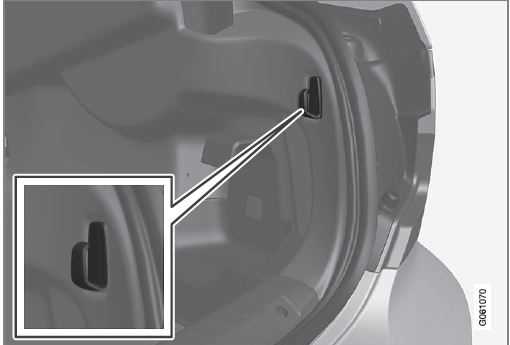 There is a bag hook in the side panel on each side of the cargo area.
There is a bag hook in the side panel on each side of the cargo area.
IMPORTANT
The bag hooks may be loaded with a maxi-mum of 5 kg (11 lbs).
Related information
Load retaining eyelets
Use the load retaining eyelets to attach straps in order to anchor items in the cargo area.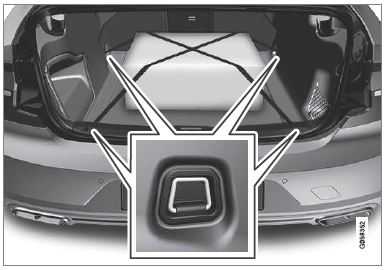 WARNING
WARNING
Hard, sharp and/or heavy objects which protrude may cause injury under violent braking. Always secure large and heavy objects with a seatbelt or cargo retaining strap.
Related information
Through-load hatch in the rear seat
The hatch in the rear seat’s backrest can be opened to transport long narrow items, e.g. skis.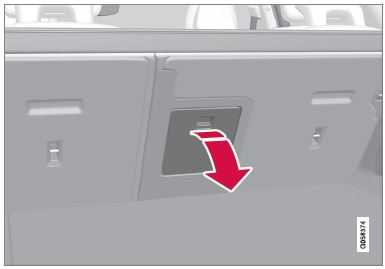 The figure is schematic – parts may vary depending on car model.
The figure is schematic – parts may vary depending on car model.
- In the cargo area, grip the hatch’s handle and fold down the hatch.
- Fold forward the armrest in the rear seat.
If the private locking function is used then the through-load hatch must be closed.
Related information
First aid kit*
The first aid kit contains first aid equipment. Store the first aid kit in an appropriate place in the cargo area, e.g. in the space on the right-hand side. The first aid kit has Velcro straps and can be attached directly to the panel.
Related information
Cargo area (p. 594)
Warning triangle
Use the warning triangle to warn other road users if the car is stationary in traffic. Also activate the hazard warning flashers.
Storage spaces
The warning triangle is fitted with two clips on the inside of the boot lid.
Folding up the warning triangle

- Remove the warning triangle’s case by opening both latches.
- Remove the warning triangle from the case, unfold it and put the ends together.
- Fold out the warning triangle’s support legs.
Follow the regulations for the use of a warning triangle. Position the warning triangle in a suit-able place with regard to traffic. Replace the warning triangle with case on the inside of the boot lid after use.
Related information
Reference Links
View Full User Guide: Volvo S90 2021-2023 User Manual
Download Manuals: https://volvo.custhelp.com/app/homeV3

